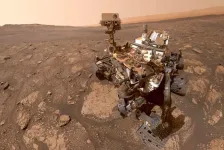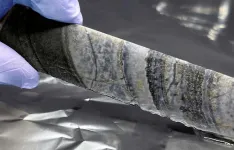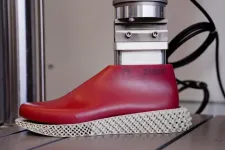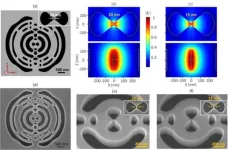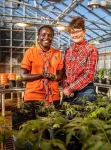(Press-News.org)
Images
The U.S. Army has extended its long-running relationship with the University of Michigan's Automotive Research Center, reaching a new five-year, agreement of up to $100 million to boost work on autonomous vehicle technologies.
This potentially doubles the federal government's financial investment with ARC since the last agreement, reached in 2019. Following its 1994 launch, the ARC has served as a source of technology and first-in-class modeling and simulation for the Army's fleet of vehicles—the largest such fleet in the world.
"We are driving the development of modern mobility systems with our advanced modeling and simulation methods, such as high-fidelity synthetic environments, virtual vehicle prototypes and virtual reality tools for human-autonomy teaming," said ARC director Bogdan Epureanu, the Roger L. McCarthy Professor of Mechanical Engineering and professor of electrical engineering and computer science.
"The cost and time needed to collect data through physical experimentation is prohibitive, and the amount of data needed to enable autonomous operation in off-road, military, emergency or disaster relief scenarios is thousands of times larger than that needed for operation in cities. Cutting-edge modeling and simulation approaches such as the ones developed in the ARC provide a critical solution to this enormous challenge."
The 14-member collection of universities and institutes, led by U-M, features a total of 84 faculty members, 34 industry partners and four government agencies. It is an ecosystem of research and innovation devoted to transforming ground system technologies.
"The University of Michigan's Automotive Research Center provides invaluable research and partnership to the U.S. Army that has helped propel the development of next-generation ground vehicle systems and other technologies vital to our men and women in uniform," said U.S. Sen. Gary Peters. "As a member of the Senate Armed Services Committee, I have repeatedly fought to ensure the ARC receives the support and resources it needs to continue this important work, and I welcome this news that it will remain an essential partner to the U.S. Army for years to come."
In the earliest years of the ARC's partnership, the bulk of its research focused on energy and powertrain issues. That work led to advances such as accurate modeling of combat personnel and their gear to assist with vehicle design, engine designs and performance simulations, blast modeling and simulation techniques, as well as a better understanding of lithium ion battery performance and design.
Some of the results cross over from military to civilian applications, such as digital engineering for reliability-based optimization of vehicle safety. Ramdo Solutions offers vehicle design tools based on technology developed at ARC.
In recent years, ARC's focus has shifted toward autonomous technologies that have become increasingly important to the military and beyond.
"The ARC is the Army's Center of Excellence in Modeling and Simulation," said David Gorsich, Army chief scientist for ground vehicles. "The research it conducts is crucial to developing the next generation of digital engineering tools to be used by government and industry.
"Using the latest digital engineering tools allows the Army community to design and develop advanced vehicle systems quickly and efficiently, bringing modern capabilities to our soldiers. These modern ground vehicles are more complex than ever before, requiring modern analysis and design tools. They are fuel-efficient, survivable, reliable, semi-autonomous and software-intensive systems. These characteristics reduce our logistical burden while increasing operational effectiveness."
The ARC brings together researchers working in engineering, machine learning, human factors and social behavior. And it fits within U-M's broader mission of exploring the future of mobility—from autonomous and connected vehicle technology to battery research for electric vehicles.
Participating institutions include: the University of Iowa; Wayne State University; Clemson University; Oakland University; Virginia Tech; Michigan Technological University; Mississippi State University; the University of Alabama at Birmingham; the University of California, Irvine; George Mason University; Central Michigan University; Michigan State University and Worcester Polytechnic Institute.
END
Off-road autonomy: U-M's Automotive Research Center funded with $100 million through 2028
As automakers explore self-driving cars, the Army-funded center will figure out how to take the tech off-road through computer modeling and simulation
2024-01-24
ELSE PRESS RELEASES FROM THIS DATE:
Atmospheric pressure changes could be driving Mars’ elusive methane pulses
2024-01-24
New research shows that atmospheric pressure fluctuations that pull gases up from underground could be responsible for releasing subsurface methane into Mars’ atmosphere; knowing when and where to look for methane can help the Curiosity rover search for signs of life.
“Understanding Mars’ methane variations has been highlighted by NASA’s Curiosity team as the next key step towards figuring out where it comes from,” said John Ortiz, a graduate student at Los Alamos National Laboratory who led the research team. “There are several challenges associated with meeting that goal, ...
New pieces in the puzzle of first life on Earth
2024-01-24
Microorganisms were the first forms of life on our planet. The clues are written in 3.5 billion-year-old rocks by geochemical and morphological traces, such as chemical compounds or structures that these organisms left behind. However, it is still not clear when and where life originated on Earth and when a diversity of species developed in these early microbial communities. Evidence is scarce and often disputed. Now, researchers led by the University of Göttingen and Linnӕus University in Sweden have uncovered key findings about the earliest forms of life. In rock ...
Post pandemic, US cardiovascular death rate continues upward trajectory
2024-01-24
Ann Arbor, January 24, 2024 – New research confirms what public health leaders have been fearing: the significant uptick in the cardiovascular disease (CVD) death rate that began in 2020 has continued. The continuing trend reverses improvements achieved in the decade before the COVID-19 pandemic to reduce mortalities from heart disease and stroke, the leading causes of death in the United States. The findings are reported in the American Journal of Preventive Medicine, published by Elsevier.
Investigators from the US Centers for Disease Control and Prevention ...
New model predicts how shoe properties affect a runner’s performance
2024-01-24
A good shoe can make a huge difference for runners, from career marathoners to couch-to-5K first-timers. But every runner is unique, and a shoe that works for one might trip up another. Outside of trying on a rack of different designs, there’s no quick and easy way to know which shoe best suits a person’s particular running style.
MIT engineers are hoping to change that with a new model that predicts how certain shoe properties will affect a runner’s performance.
The simple model incorporates ...
Sub-wavelength confinement of light demonstrated in indium phosphide nanocavity
2024-01-24
WASHINGTON — As we transition to a new era in computing, there is a need for new devices that integrate electronic and photonic functionalities at the nanoscale while enhancing the interaction between photons and electrons. In an important step toward fulfilling this need, researchers have developed a new III-V semiconductor nanocavity that confines light at levels below the so-called diffraction limit.
“Nanocavities with ultrasmall mode volumes hold great promise for improving a wide range of photonic ...
Laura M. Barzilai, JD, LLM, elected Chair of Board of Directors of the American Federation for Aging Research (AFAR)
2024-01-24
NEW YORK— The American Federation for Aging Research (AFAR), a national, nonprofit whose mission is to advance and support healthy aging through biomedical research, is pleased to announce the election of Laura M. Barzilai, JD, LLM, as Chair of the Board of Directors.
Stephanie Lederman, EdM, AFAR Executive Director, shares: "The Board of Directors of AFAR unanimously elected Laura Barzilai as Chair in December 2023. For nearly a decade, her contributions as a board member, committee chair, ...
Talking tomatoes: How their communication is influenced by enemies and friends
2024-01-24
Plants produce a range of chemicals known as volatile organic compounds that influence their interactions with the world around them. In a new study, researchers at the University of Illinois Urbana-Champaign investigated how the type and amount of these VOCs change based on different features of tomato plants.
The smell of cut grass is one of the defining fragrances of summer. Smells like that are one of the ways plants signal their injury. Because they cannot run away from danger, plants have evolved to communicate with each other using chemical signals. They use VOCs for a ...
Thomas A. Rando, MD, PhD, elected President of the Board of Directors of the American Federation for Aging Research (AFAR)
2024-01-24
The American Federation for Aging Research (AFAR), a national, nonprofit whose mission is to advance and support healthy aging through biomedical research, is pleased to announce the election of Thomas A. Rando, MD, PhD, as President of the Board of Directors in December 2023.
Dr. Rando is currently the Director of the Eli and Edythe Broad Center of Regenerative Medicine and Stem Cell Biology at UCLA, where he is a professor of Neurology and Molecular, Cell, and Developmental Biology. Previously, he ...
Fast-charging lithium battery seeks to eliminate ‘range anxiety’
2024-01-24
ITHACA, N.Y. – Cornell University engineers have created a new lithium battery that can charge in under five minutes – faster than any such battery on the market – while maintaining stable performance over extended cycles of charging and discharging.
The breakthrough could alleviate “range anxiety” among drivers who worry electric vehicles cannot travel long distances without a time-consuming recharge.
“Range anxiety is a greater barrier to electrification in transportation than any of the other barriers, like cost and capability of batteries, and we have identified a pathway to eliminate it using rational electrode designs,” said Lynden ...
Chemistry professor R. Graham Cooks expands research of water droplet interfaces that offer the secret ingredient for building life
2024-01-24
R. Graham Cooks, the Henry B. Hass Distinguished Professor of Chemistry, and his postdoctoral researcher Lingqi Qiu have experimental evidence that the key step in protein formation can occur in droplets of pure water, and have recently published these findings in the Proceedings of the National Academy of Sciences (PNAS).
In this key step, amino acids are dehydrated (they lose water) even though they are in a water solution, a paradox that is resolved by the fact that these droplet surfaces are unusually dry and highly ...
LAST 30 PRESS RELEASES:
Shingles vaccine linked to slower biological aging in older adults
A self-assembling shortcut to better organic solar cells
A two-week leap in breeding: Antarctic penguins’ striking climate adaptation
Climate risks to insurance and reinsurance of global supply chains
58% of patients affected by 2022 mpox outbreak report lasting physical symptoms
Golden Gate method enables rapid, fully-synthetic engineering of therapeutically relevant bacteriophages
Polar weather on Jupiter and Saturn hints at the planets’ interior details
Socio-environmental movements: key global guardians of biodiversity amid rising violence
Global warming and CO2 emissions 56 million years ago resulted in massive forest fires and soil erosion
Hidden order in quantum chaos: the pseudogap
Exploring why adapting to the environment is more difficult as people age
Society for Laboratory Automation and Screening welcomes new scientific director: Madeline M. Farley, Ph.D.
Austrian cow shows first case of flexible, multi-purpose tool use in cattle
Human nasal passages defend against the common cold and help determine how sick we get
Research alert: Spreading drug costs over the year may ease financial burden for Medicare cancer patients
Hospital partnership improves follow up scans, decreases long term risk after aortic repair
Layered hydrogen silicane for safe, lightweight, and energy-efficient hydrogen carrier
Observing positronium beam as a quantum matter wave for the first time
IEEE study investigates the effects of pointing error on quantum key distribution systems
Analyzing submerged fault structures to predict future earthquakes in Türkiye
Quantum ‘alchemy’ made feasible with excitons
‘Revoice’ device gives stroke patients their voice back
USF-led study: AI helps reveal global surge in floating algae
New method predicts asthma attacks up to five years in advance
Researchers publish first ever structural engineering manual for bamboo
National poll: Less than half of parents say swearing is never OK for kids
Decades of suffering: Long-term mental health outcomes of Kurdish chemical gas attacks
Interactional dynamics of self-assessment and advice in peer reflection on microteaching
When aging affects the young: Revealing the weight of caregiving on teenagers
Can Canada’s health systems handle increased demand during FIFA World Cup?
[Press-News.org] Off-road autonomy: U-M's Automotive Research Center funded with $100 million through 2028As automakers explore self-driving cars, the Army-funded center will figure out how to take the tech off-road through computer modeling and simulation
